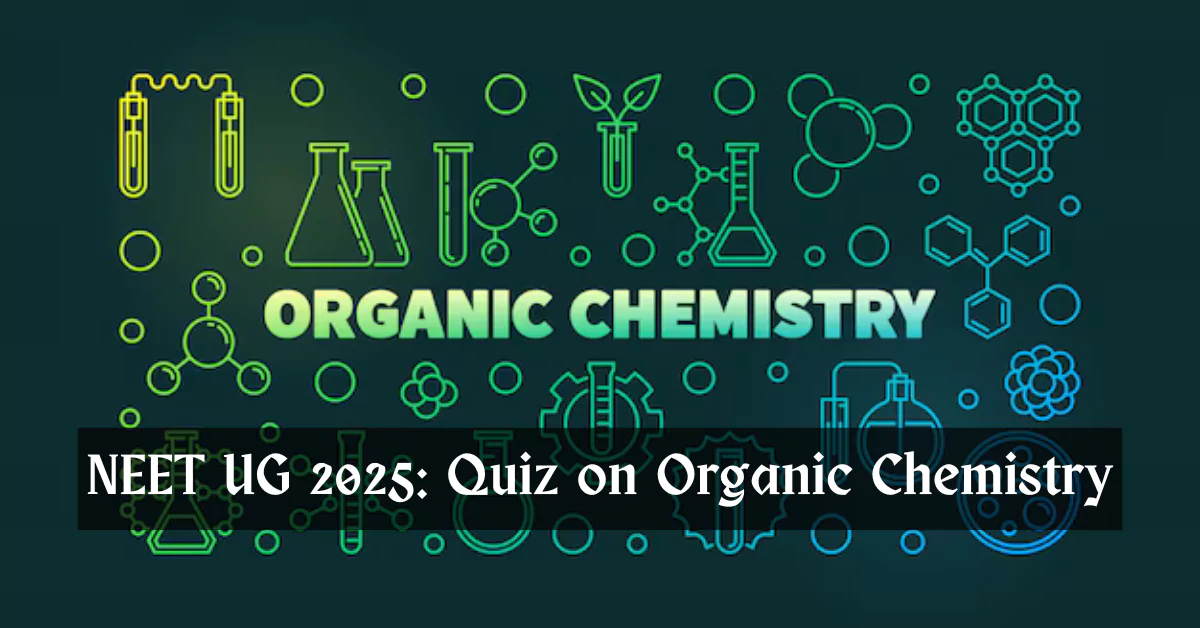NEET UG 2025: As the NEET exam approaches, aspirants are diving deep into advanced topics to gain a competitive edge, particularly in Organic Chemistry, a section known for its conceptual depth and tricky application-based problems.
To support students’ preparation, a curated set of 25 Organic Chemistry MCQs has been compiled by edufever academic team. These questions target core concepts, reaction mechanisms, functional group behavior, and stereochemistry—areas critical to scoring high in NEET.
Organic Chemistry MCQs: Set 4
1. The major product of the reaction between phenol and chloroform in the presence of NaOH is:
(a) Salicylic acid
(b) o-Hydroxybenzaldehyde
(c) p-Hydroxybenzaldehyde
(d) Benzoic acid
| NEET UG Counselling Guide 2025 | |
|---|---|
| State-wise MBBS/BDS Counselling Guide eBook 2025 | 📥 Download |
| MCC NEET UG Counselling Guide eBook 2025 | 📥 Download |
| AACCC AYUSH NEET Counselling Guide eBook 2025 | 📥 Download |
2. Which compound gives a positive Iodoform test?
(a) Ethanol
(b) Methanol
(c) Acetone
(d) Both (a) and (c)
3. The correct order of acidic strength is:
(a) Phenol > Ethanol > Acetic acid
(b) Acetic acid > Phenol > Ethanol
(c) Ethanol > Acetic acid > Phenol
(d) Phenol > Acetic acid > Ethanol
4. Which reagent will distinguish between primary, secondary, and tertiary alcohols?
(a) Lucas reagent
(b) Tollen’s reagent
(c) Fehling’s solution
(d) 2,4-DNP
5. Which compound shows tautomerism?
(a) Benzaldehyde
(b) Acetone
(c) Acetic acid
(d) Ethanol
6. Which of the following compounds will undergo aldol condensation?
(a) Formaldehyde
(b) Benzaldehyde
(c) Acetaldehyde
(d) Acetic acid
7. Which of the following is least reactive towards nucleophilic substitution?
(a) CH₃Cl
(b) CCl₄
(c) CH₃CH₂Cl
(d) CH₂=CHCl
8. Which compound will give a positive carbylamine test?
(a) Aniline
(b) Benzamide
(c) Nitrobenzene
(d) Phenol
9. The product of the reaction between CH₃MgBr and CO₂ followed by acid hydrolysis is:
(a) Acetic acid
(b) Ethanol
(c) Methanol
(d) Propanoic acid
10. Which is the correct order of basicity?
(a) NH₃ > CH₃NH₂ > (CH₃)₂NH
(b) (CH₃)₂NH > CH₃NH₂ > NH₃
(c) NH₃ > (CH₃)₂NH > CH₃NH₂
(d) CH₃NH₂ > NH₃ > (CH₃)₂NH
11. The stability of carbocations follows the order:
(a) 1° > 2° > 3°
(b) 3° > 2° > 1°
(c) 2° > 3° > 1°
(d) 1° > 3° > 2°
12. The product formed when benzene reacts with CH₃COCl in the presence of AlCl₃ is:
(a) Benzyl alcohol
(b) Acetophenone
(c) Toluene
(d) Benzaldehyde
13. The product of the Hoffmann bromamide reaction of acetamide is:
(a) Acetic acid
(b) Acetone
(c) Methylamine
(d) Ethylamine
14. Which of the following gives a violet colour with neutral FeCl₃?
(a) Phenol
(b) Alcohol
(c) Aldehyde
(d) Ketone
15. Which compound undergoes the Cannizzaro reaction?
(a) Acetaldehyde
(b) Benzaldehyde
(c) Propanal
(d) Butanone
16. The correct order of reactivity towards electrophilic substitution is:
(a) Nitrobenzene > Benzene > Toluene
(b) Toluene > Benzene > Nitrobenzene
(c) Benzene > Nitrobenzene > Toluene
(d) Nitrobenzene > Toluene > Benzene
17. Which of the following is most acidic?
(a) Acetylene
(b) Ethylene
(c) Ethane
(d) Benzene
18. Which of the following is an example of Markovnikov’s rule?
(a) CH₃CH=CH₂ + HBr → CH₃CHBrCH₃
(b) CH₃CH=CH₂ + HBr (peroxide) → CH₃CH₂CH₂Br
(c) CH₂=CH₂ + Br₂ → CH₂Br–CH₂Br
(d) CH₃CH=CH₂ + HCl → CH₃CHClCH₃
19. Which of the following reacts fastest with Lucas reagent?
(a) 1° alcohol
(b) 2° alcohol
(c) 3° alcohol
(d) Methanol
20. The hybridization of carbon in H–C≡N is:
(a) sp
(b) sp²
(c) sp³
(d) sp³d
21. Which statement is true about the mesomeric effect?
(a) It operates through space
(b) It is temporary
(c) It involves the delocalization of π electrons
(d) It decreases with increasing chain length
22. Which of the following is not aromatic?
(a) Benzene
(b) Cyclobutadiene
(c) Naphthalene
(d) Pyrrole
23. Which of the following compounds will give optical isomerism?
(a) 2-chlorobutane
(b) 1-chlorobutane
(c) But-1-ene
(d) Butanoic acid
24. Which of the following is an example of an enolizable ketone?
(a) Acetone
(b) Benzaldehyde
(c) Acetophenone
(d) All of these
25. Which of the following compounds is most reactive towards an SN1 reaction?
(a) Methyl bromide
(b) Ethyl bromide
(c) tert-Butyl bromide
(d) Isopropyl bromide
✅ Answer Key:
1.(b), 2.(d), 3.(b), 4.(a), 5.(b), 6.(c), 7.(b), 8.(a), 9.(a), 10.(b), 11.(b), 12.(b), 13.(c), 14.(a), 15.(b), 16.(b), 17.(a), 18.(a), 19.(c), 20.(a), 21.(c), 22.(b), 23.(a), 24.(d), 25.(c)
Share your quiz scores in the comments section, and our experts will review your performance to provide personalized tips to help you improve your NEET score.
Organic Chemistry remains a high-weightage topic in NEET UG, often determining a student’s rank. These 25 tough MCQs provide a comprehensive and challenging set for aspirants aiming to perfect their preparation. Mastering such questions ensures not only better scores but also builds confidence to handle the unexpected in the real exam.


